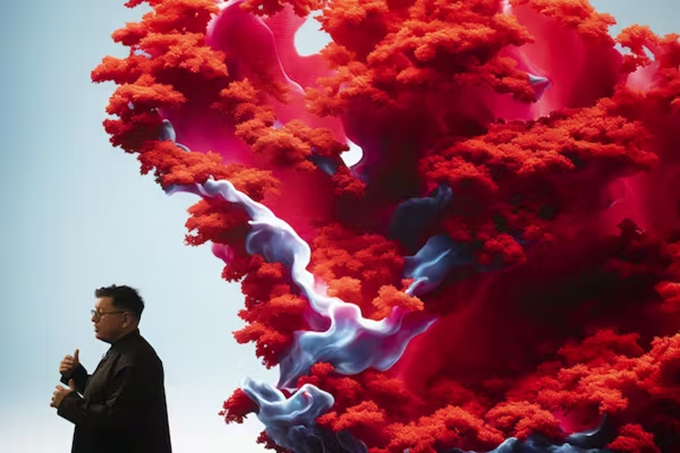
Artificial intelligence (AI) carries with it the seeds of major impacts in many sectors of society over the coming decades. Some of these effects could be positive, others less so.
When ChatGPT was released , the teaching profession, proud of its integrity and high ethical standards, feared that AI could expand opportunities for student cheating . The question remains relevant.
Some education experts have pushed for their institutions to adopt new policies, including advocating for the return of face-to-face exams. Others thought that AI was just a fad, waiting for it to pass its way.
Of course, AI is not likely to disappear from our horizons. As a member of the education community, I wondered where my profession might find valuable lessons regarding the adoption of this technology. One of the models to use for developing new approaches could come from the world of art. Artists have long explored the intersection between technology and creativity.
Painter David Hockney is one of the most famous artists to embrace AI. In June 2023, he exhibited an AI-generated work on the Pyramid Stage at the 2023 Glastonbury Festival. Titled I Lived In Bohemia, Bohemia Is A Tolerant Place , the work was developed as a video ‘one minute.
While this is only his first AI-generated work, Hockney has already used various analog and digital technologies for many years. He notably used the Xerox photocopier, the Quantel Paintbox and a computer graphics workstation. These technologies have helped to open up the sensory and creative potential of one’s gaze. His recent immersive art installation in London, David Hockney: Bigger & Closer , attests to his reputation as an innovator.
New artistic experiences with AI
Hockney is not the only one to have ventured into this area. Many artists have found creative and innovative ways to use AI in their work. Robbie Barrat is a contemporary artist who explores the intersections between art and artificial intelligence. He is known for his work on generative adversarial networks , a model where two machine learning systems are placed in competition to produce better results. These networks have been used to create realistic artificial faces and have been so successful at it that people often can’t tell the difference between an AI-generated face and a real one .
In one project, Barrat trained a generative adversarial network on a dataset of classical nude paintings. He incorporated his own digital sketches and drawings into the trained network, generating unique and surreal interpretations of the human form. By scanning or digitizing sketches and feeding them into the AI model, it allowed the system to produce new compositions . The resulting artworks feature a fusion of his artistic style and AI models learned from classic paintings.

Refik Anadol next to one of his AI-based works, titled Artificial Realities: Coral. GIAN EHRENZELLER/EPA IMAGES
Other artists have integrated AI with augmented reality (AR) and virtual reality (VR) to create immersive and interactive experiences.
For example, Refik Anadol uses algorithms to process and interpret large amounts of data and transform them into spectacular works of art. It incorporates these AI-generated visuals into augmented reality and virtual reality experiences to
create hypnotic and interactive installations .
Human expertise essential to take advantage of technologies
Of course, not all artists are so enthusiastic about this technology. Many perceive image generators such as DALL-E and Midjourney as a threat. But the fact that great artists like Hockney and Anadol have used AI to pose new challenges is a signal. Teachers should consider how to use AI in their lessons and assessments.
The education sector’s reluctance to adopt AI can be understood as it is surrounded by myths and misconceptions . It is therefore appropriate to dispel some of these beliefs.
The first is that AI would harm learning experiences. Some educators fear that if students rely on AI, their thinking and problem-solving skills will be compromised , as well as their ability to absorb information independently. However, the key to successfully integrating AI into education is helping students understand that intelligent tools are not a replacement for human expertise and are just tools to increase and improve it .
The second myth is that AI would “isolate” learners. While AI can provide personalized feedback and support, it cannot replace human interaction with a teacher or the social and emotional learning that comes with it.
Some academics fear that an over-reliance on AI could lead to a feeling of disconnection between students and their supervisors. In fact, teachers can use AI systems to help students learn collaboratively and solve problems collectively.
The third myth is that AI will stifle creativity . However, its introduction as a technology can support and strengthen creativity in training . For example, generative AI tools can be used to promote divergent thinking, challenge biases, help evaluate ideas, encourage refinement of thinking, and facilitate collaboration.
Skills for tomorrow’s working world
The fourth and final misconception is that AI would encourage learners to cheat on exams. But this way of looking at things only captures a very small part of the story . By effectively integrating artificial intelligence into assessments, we can help students master it, giving them the skills they will need in life .
We should design assessments that promote the application of knowledge, skills and understanding in real-world contexts.
AI can be used as a collaboration tool, a source of inspiration and a helpful guide. It is closely linked today to educational issues to the extent that learners must be able to collaborate with AI in the working world of tomorrow .
Artists have made possible what was previously unimaginable. Today, education professionals can do the same, empowering students to become critical thinkers and creative problem solvers ready for a future where AI is commonplace.
Author Bio: Lucy Gill Simmen is Vice-Dean for Education & Student Experience at Royal Holloway University of London
